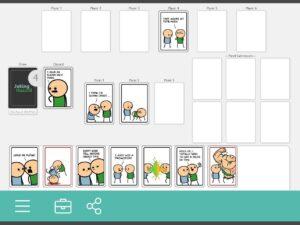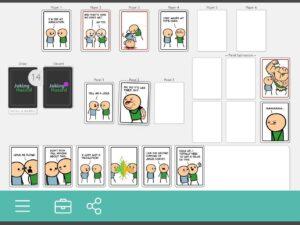Background
Joking Hazard is a judging card game (with online versions) in the vein of Cards against Humanity and Apples to Apples, published in 2016 by Explosm. The game is targeted towards older audiences who appreciate the mature, sometimes crass humor behind the popular web comic Cyanide & Happiness, on which this game is based.

The game is technically a multilateral competition game where the objective for each player is to outwit competitors with their responses, but the outcome feels like a non-zero-sum condition because it feels like everyone wins from being able to experience funny jokes. The competition doesn’t feel critical, and the game is more about “how can I be funny” and less about “I want to defeat my competitors”. Perhaps this is because of the collaborative elements of the game where you’re ultimately working together to build a funny joke. In that regard, fellowship is an important aesthetic, and the game is great for building community amongst players because you’re able to bond and create memories about funny jokes that are only acceptable in that shared, inimitable context.
Types of Fun – Expression
This game works particularly well because it gives players the chance to tap into a raunchier sense of humor that might not be as socially acceptable in different contexts, free of judgement. The cards (seen in the screenshot above) are designed to be extremely crude so the players can joke about things behind the excuse: “it’s the game, not me”. This does a great job of lowering respectability inhibitions and allowing expression to serve as a core aesthetic. Using comic panels as prompt cards is a mechanic unique to this game that benefits this because you can tell richer, more expressive punchlines through images. For example, a card that described someone hulking out would not land the same way it does in the screenshot below where you can see it.
The game mechanics encourage two forms of expression. One, theres an aspect of expressing your creativity and your storytelling capabilities in thinking of creative, witty ways to apply the cards you have, to create the funniest response to the prompt. Then, there is expression in that serving as the judge and selecting the best response reflects your tastes and sense of humor.

Comparison to Similar Games
One distinguishing procedural element that sets this game apart from comparable games is that the judge submits two cards (some images, some text, and images) to start a comic strip that the other players must complete with a punchline. So, where in games like cards against humanity you’re trying to tell a short joke, here you’re trying to tell a story. I think this works to this games favor because having two image-based cards gives you more material to work with in crafting a story, so there are fewer instances where you’re just dumping cards that aren’t particularly funny, or that don’t fit/make sense with the prompt. I think it would be interesting to push this in creating some rounds where players can only use cards with no text or rounds where you pass some of the cards in your hand to your neighbor to see how they can use them creatively.
Another interesting unique mechanic is that there isn’t much functional difference between “prompt” cards and punchline cards. While the distinction is made, both can be applied in any context and I think that eliminates some of the gameplay limitations that exist in apples to apples, that lead to dynamics like card dumping.
This also allows for the inclusion of special rounds where the prompt structure is inverted: the judge sets down the punchline for other players to fill in the buildup story/scenario. I think this exercises a different form of creativity and breaks some of the repetition that might induce boredom and prevent the game from introducing new patterns/twists.



